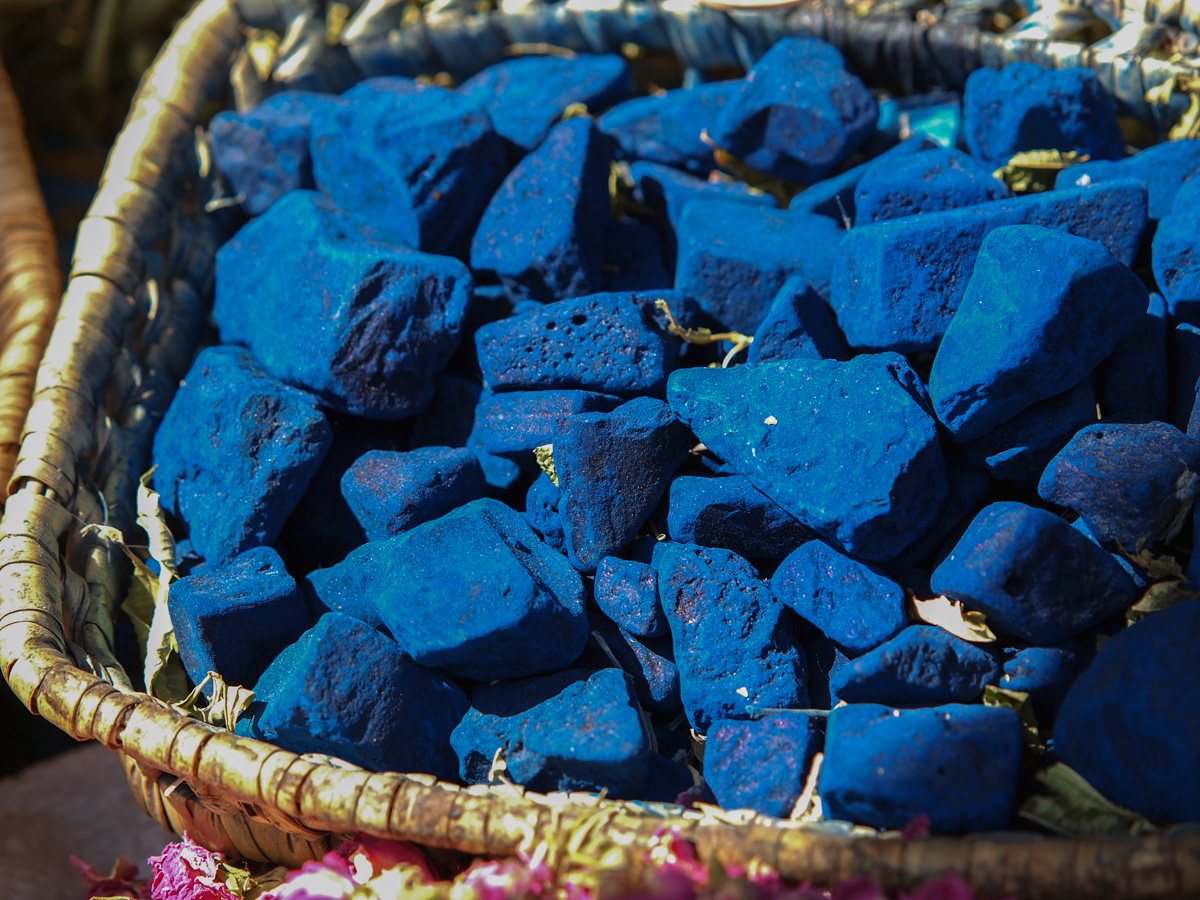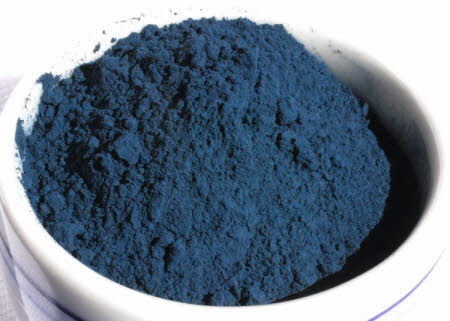

Chemically speaking, a base is the opposite of an acid. In order for the reducing agent to act on the indigo, a basic environment is required. When the indigo is reduced it dissolves and the dye bath is a greeny-yellow colour. If we can see the indigo (the dye bath is blue inside) then the indigo is not dissolved and the dye bath cannot be used to for dyeing. You can see the fish (which remains distinct) you cannot see the salt (which has dissolved). What is the difference between a suspension and a solution? A fish is suspended in the ocean. We’ve brought together block printers from Rajasthan and the Kutch desert and placed them in the same natural dye studio as ikat weavers from the south and eri silk farmers from Ethiopia. We have worked with historians like Jenny Balfour Paul, researchers like Dominique Cardon, and botanist-chemists like Michel Garcia. Maiwa, after thirty years, has formed an intimate relationship with indigo. Decades of processing indigo had stained them a deep blue-as dark as the tropical night. There also were the cement extraction tanks. There were the fields, the oxcarts working early in the morning to bring in the fresh cut indigo plants. One day, fifteen years ago, someone recommended that we make a trip to Andhra Pradesh in South India. It took us years to trace indigo blue back to the fields where it was growing. The experience of working and dyeing with indigo is so powerful, there is such magic in the process, that if we began with indigo, the students would never move on to the other colours. In contrast, when we are teaching, indigo is last. When exploring a new relationship with block printers, or scaling up a weaving or dyeing project, indigo is first. Blue seems to be both universal and at the same time deeply tied to the culture that uses it. Remarkably, indigo was also used in Central and South America, where it was independently discovered. Ancient cultures-Greek, Roman, Chinese, Japanese, Indian-all created distinctive textiles based on indigo blue. Indigo has great longevity: archeological evidence of its use dates back to Indus valley civilization in the third millennium BCE.
#Blue indigo dye how to#
It had been a little over one hundred years since the German chemist Adolph von Baeyer had discovered the chemical formula for indigo and worked out a way to synthesize it industrially. During that time farmers who grew indigo and those who knew how to extract it became increasingly rare.

The word “indigo” was everywhere, but the legendary dyeplant proved much more elusive.
#Blue indigo dye free#
If you are new to natural dyes, we have a free guide to getting started with natural dyes.Decades ago, Maiwa began looking for blue. While they are not as consistently repeatable or as durable as many synthetic dyes, they are far more environmentally friendly and, in our opinion, absolutely unmatched in magic and beauty. Natural dyes create unique living colours that will evolve and wear over time as they are washed, worn, and loved creating colours and garments that are alive, telling the story of their use. Natural dyes and mordants are available in our online store. For best results, natural fibres should be pre-prepared using a mordant or tannin before dyeing. Natural dyes can only be used on natural fibres (cotton, linen, wool, bamboo, hemp, silk). All of our dye plant material is dried on site immediately after harvest to preserve quality and maximum vibrancy of colour. This natural plant dye was grown with care on our small farm in Nova Scotia’s Annapolis Valley. We have only a very limited quantity of our indigo powder available.

They can be an affordable option to get started with dyeing blues – and, of course, they produce lovely results in their own right. Key Modifiers: Indigo can be used to over-dye other colours such as yellows to produce greens or reds to produce purples.įor a lighter range of blues and teals, you can use dried indigo leaves.

When dyeing with indigo powder, you do not need to mordant your fibres before dyeing.Ī 50g jar will dye: 250g of fibre a deep dark shade, 500g a rich medium shade, and up to 2kg a pale shade. You can use any of your go-to vat processes. We have had the best results with: 1 part indigo powder, 1 part calcium hydroxide, 3 parts fructose. We typically use a fructose vat with a reduced quantity of calcium hydroxide. Key Dye Colours: Light blue to dark blue.ĭye Process: The indigo dyeing process requires a vat.


 0 kommentar(er)
0 kommentar(er)
